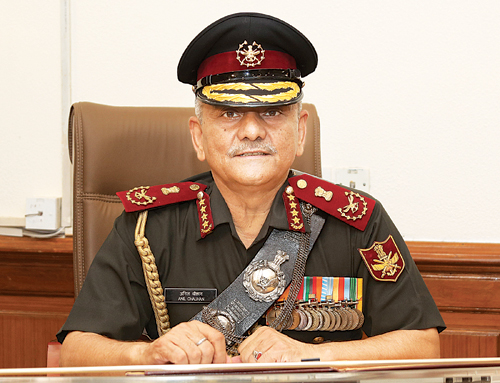INDIAN ARMED FORCES CHIEFS ON
OUR RELENTLESS AND FOCUSED PUBLISHING EFFORTS

SP Guide Publications puts forth a well compiled articulation of issues, pursuits and accomplishments of the Indian Army, over the years

I am confident that SP Guide Publications would continue to inform, inspire and influence.

My compliments to SP Guide Publications for informative and credible reportage on contemporary aerospace issues over the past six decades.
No compromise on war fighting efficiency
General Anil Chauhan, the new CDS, is the first retired three-star officer to return to service in four-star rank. He will also function as Secretary, Department of Military Affairs.

The government has finally appointed the next Chief of Defence Staff (CDS), nine months after the death of the first CDS, General Bipin Rawat and 12 others in a helicopter crash.
The announcement puts to rest various rumours, whether the post of CDS is required at all or is the post likely to be split between the CDS and Secretary, Department of Military Affairs (Secy. DMA).
Lt General Anil Chauhan assumed the charge in the rank of a four-star General. He is the first retired three-star officer to return to service in four-star rank. He will also function as Secretary to Government of India, Department of Military Affairs.
Earlier, in June this year, government amended the selection criteria for appointment of any serving or retired Lt General or equivalent, under the age of 62, to the post of CDS. This change paved the way for selection of Lt General Chauhan to the post of CDS.
The appointment of Lt General Anil Chauhan (Retd) as the CDS is a welcome move. But he now faces many challenges. His tenure begins under the fast changing geopolitical situation. The ongoing Russian-Ukranian conflict is springing new surprises with equation amongst various countries undergoing changes. New weapons are being employed on the battlefield, prolonged conflict paradigm is taking shape and the increasing risk of escalation is bringing use of nuclear option into calculus.
Closer home, India has a 3,488 kms long contentious line of actual control (LAC) with China. The standoff between the two countries has entered 29th month, despite disengagement at a few locations, there still are substantial troops, tanks, artillery and air force assets deployed in the Ladakh area. Even though the two sides have had limited success in disengaging, a full resolution is still not in sight as they are far from de-escalation.
Chinese Air Force has increased the number of air violations along the LAC. Also, China has been increasing its naval activity in the Indian Ocean Region (IOR), including the docking of the Yuan Wang 5 ship in Sri Lanka. The China-Taiwan region has been witnessing renewed aerial and maritime activities.
The changing geopolitical scenario makes the task of the new CDS even more challenging. The Russian-Ukranian war brings out that a strong military- well equipped and better trained- is a necessity to ward-off threats. Indian government has continued to delegate emergency procurement powers to the service headquarters, indicating that there are critical shortages. These shortages would need to be prioritised under a long term capability development strategy. The Indian Army needs light tanks for high altitude operations, more firepower. The IAF has only 31 squadron of fighter aircraft and has placed orders for 83 Tejas LCA Mk 1A, it is ready to place orders for Tejas Mk2 and Advance Medium Combat aircraft as and when both are developed and ready for production. In the meantime, case for 114 Multi Role Fighter Aircraft has been dragging endlessly and pending for issue of tender, needs to be prioritised. The submarine Project 75(I) of the Indian Navy (IN) needs to be fine tuned to meet their aspirations, also a call needs to be taken about the need for a third aircraft carrier for the Navy. All procurement issues need tough decision making in view of constraints of defence budget.
While the government’s impetus of defence manufacturing is under the ‘Atmanirbhar Bharat’ scheme, there is also a requirement to make the DPSUs and our R&D organisations accountable for quality and meeting the timelines to meet the operational aspirations of the armed forces and the nation.
The other issue is of theaterisation that the previous CDS was actively steering, but it did lead to an acrimonious debate. The new CDS needs to develop a better professional understanding of employment philosophy and doctrine of each service among all the stakeholders and work out operational philosophy, honouring those templates. IAF’s doctrinal reservation about dividing its meager resources into different theatres needs to be given due weightage. Possibly establishment of the Cyber, Space and Missile command could be considered ahead of theatre commands.
Notwithstanding the above, as Secretary DMA, one of the most important agenda would be optimisation of manpower and to take the newly announced Agnipath scheme to its logical deployment within the armed forces at the field level and offer tangible alternate avenues for those leaving after a limited contractual period.
The Indian Armed Forces, the Indian Defence Industry and nation as a whole has expectations. All stakeholders are looking forward as to how would all these be tackled without compromising the war fighting efficiency of the country. The task is daunting, we wish him well!





